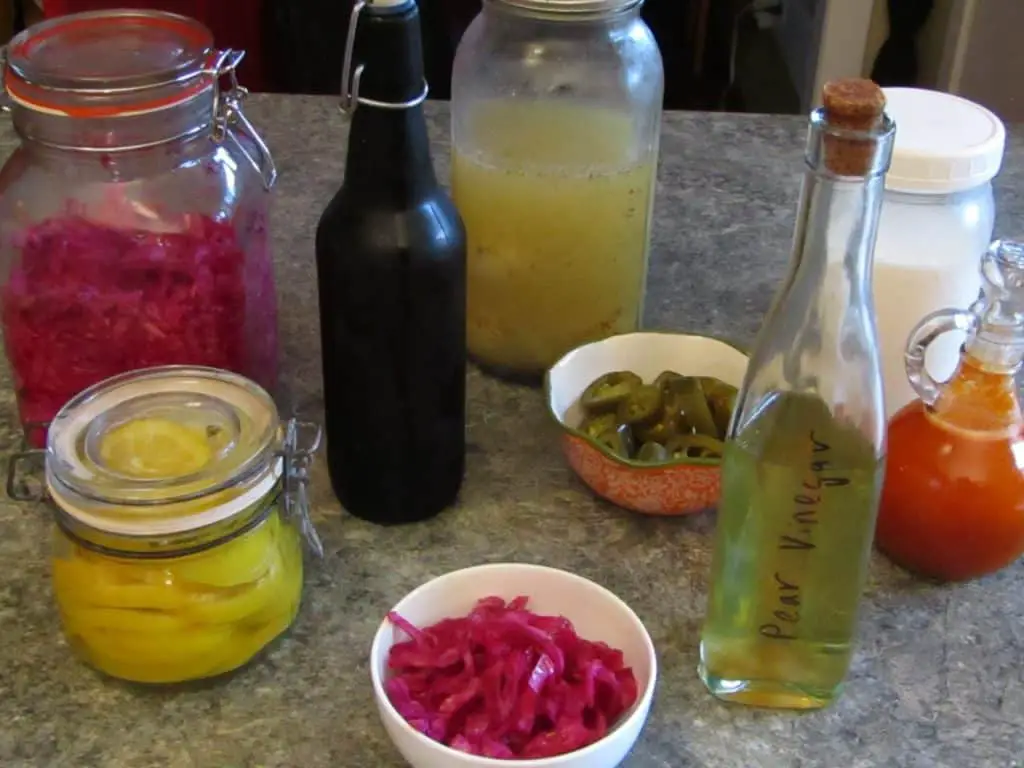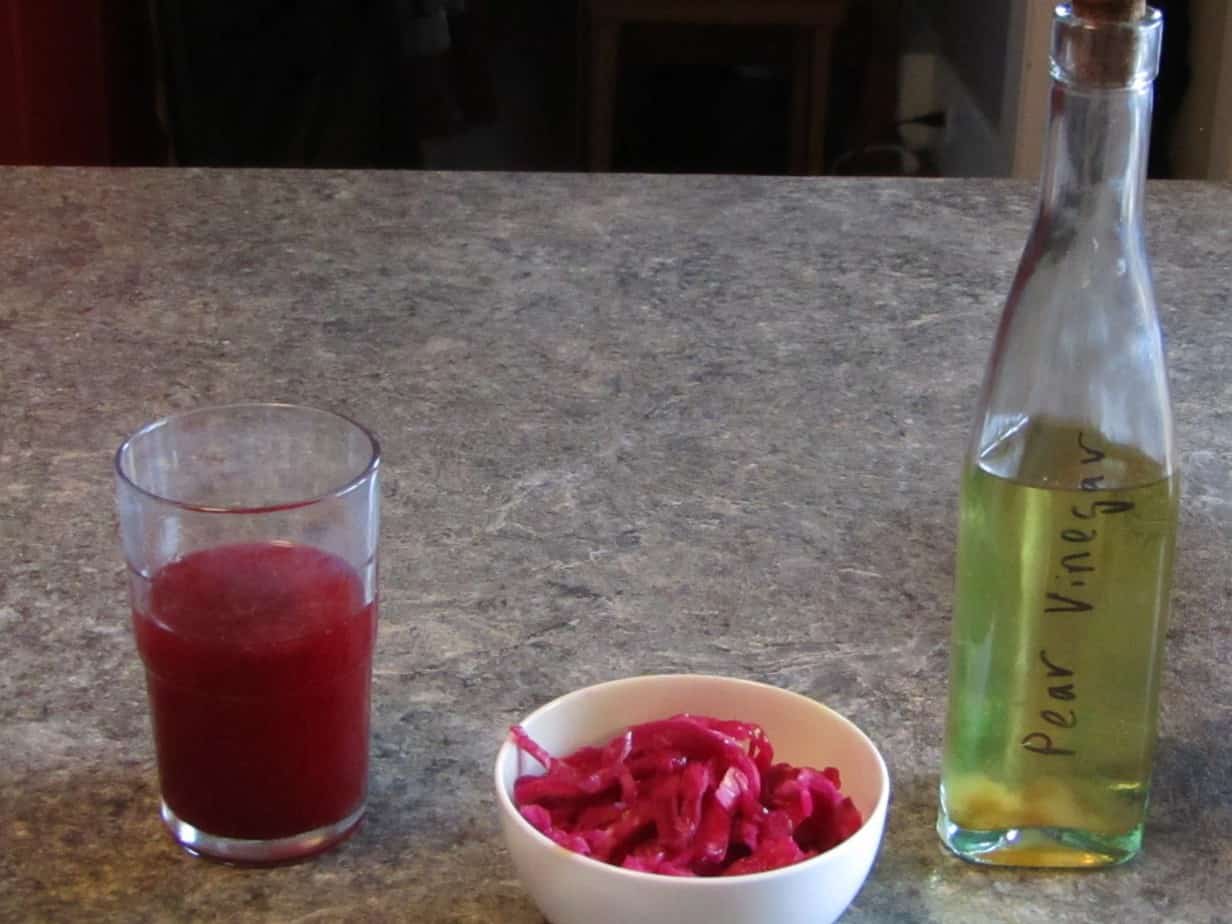This post contains affiliate links.
We hear fermented foods being promoted everywhere, even the medical establishment has conceded that eating a diet with some fermented foods is good for your health. With the popularity of food and drinks like kombucha and kimchi it has risen in cultural consciousness. Many companies are getting on the bandwagon but not all of these companies are actually fermenting their products. So what does it mean when a food is fermented?
A food is fermented when it is placed in a controlled environment to promote specific microbial growth. This consumes sugars found in the food and produces organic acids, alcohols and carbon dioxide. It can be started by naturally occurring microorganisms or be inoculated with specific cultures.
There are many types of fermented foods from sauerkraut to balsamic vinegar and each one is fermented differently, using a different type of culture which can be pure strains of specific bacteria or a consortium of bacteria, yeasts and molds which produce unique flavors and storage characteristics.
There are three main microorganism families which are used to ferment food:
- Yeast and other fungi
- Acetic acid bacteria
- Lactic acid bacteria
Each of these three need different environmental conditions for encouraging growth and it is by controlling these conditions which produce the wide variety of fermented foods.
Environmental conditions needed for yeast growth
Yeast is an integral part of many fermented food products including wine, sourdough bread, kefir, vinegar and kombucha. Yeast species can survive in a wide variety of environments which makes them valuable and problematic at the same time.
Yeasts can grow with or without oxygen, need simple sugar for energy, can grow in a temperature range of 0℃- 47℃ and tolerate a pH of 4.0. While most yeast species cannot survive ABV greater than 4% some yeasts such as saccharomyces cerevisiae are tolerant to 18% – 20% ABV.
These environmental conditions help fermenters to produce a wide variety of yeasted foods such as alcohol, vinegar, bread and kombucha. Each of these require a different set of conditions to produce the expected product.
Yeasts are a subspecies of the fungus family. Other fungi are also used in fermentation which provide other functions. Two examples of this are the mold Aspergillus oryzae and Rhizopus oligosporus.
Aspergillus oryzae is used in the production of many Japanese fermentations such as sake, miso and soy sauce. This mold has the ability to convert complex carbohydrates (starch) into simple sugars which other microorganisms can use. It breaks down the rice starch used to make sake, starch found in the soybeans in the production of soy sauce and the starch found in the barley and soybean mix used to make miso.
Rhizopus oligosporus is used in the production of tempeh. It also uses the complex starches found in the beans and/or seeds used to make the tempeh. Under specific environmental conditions it can grow quickly and form a white mycelia around the beans/seeds.
Environmental conditions needed for acetic acid bacteria
AAB are an interesting bacterium which can use sugar, alcohol and acetic acid for energy and in most samples all three of these types of AAB are present. They are used to produce vinegar, kombucha and are present in all yeasted products including wine, beer and bread.
Acetic acid bacteria need oxygen for respiration, have an effective temperature range of 25-30 and tolerate a pH of 2.0. They have tolerance to alcohol up to 16% ABV but grow much better within the range of 5% – 12% ABV.
By controlling the environment you can encourage or discourage the growth of acetic acid bacteria. Wine and beer makers place their alcoholic fermentations in anaerobic environments to limit the growth of acetic acid bacteria while vinegar makers promote the exposure to oxygen.
Mixed fermentation types like kombucha and water kefir rely on the growth of yeasts and acetic acid bacteria simultaneously which helps to balance the culture as well as keep the alcohol level low.
Environmental conditions needed for lactic acid bacteria
LAB uses sugar to produce lactic acid. Their use in the production of sauerkraut, pickles and other fermented vegetables makes a tangy and well preserved product which can last a long time in proper storage conditions.
Lactic acid bacteria are anaerobic in nature, have a wide temperature range of 20-45 and tolerate a pH of 2.0. They have tolerance to alcohol up to 15% ABV. Some species of lactic acid bacteria are inhibited at 6% ABV whereas some are tolerant up to 15% ABV.
Fermenting vegetables with lactic acid is very safe and is quite forgiving when mistakes are made. The safety of this type of fermentation is a result of active lactic acid bacteria which are present (some of which are probiotic) on fruits and vegetables. By encouraging their growth they quickly dominate a fermentation, producing a valuable finished product.
Why fermented foods are safe to eat
When you first start fermenting food it seems counterintuitive to how food should be treated. How can stuffing a vegetable into a jar with some salt and water and then leaving it on the counter in ambient temperatures lead to food which is not only safe but delicious?
The usual answer to this is because the naturally occurring bacteria found on the food acidifies the environment which prevents the growth of unwanted spoilage and pathogenic bacteria. But there is much more to it than that.
Fermented foods are safe because the environment is strictly controlled to encourage wanted microorganisms and discourage unwanted ones. Some fermentations use naturally occurring microbes whereas others need to be inoculated with specific cultures for specific results.
If food is left out on the counter or uncovered in the fridge it will not turn into delicious fermented food. Although it will ferment to some degree other microorganisms will also grow in and on the food to produce a slimy smelly mess. Molds and spoilage bacteria are everywhere and can easily grow wherever there is food.
Most molds produce toxins which are inedible for people. It is the toxins mold produces which give the food a bad flavor. Spoilage bacteria also produce bad odors and pour texture which makes them unappetizing.
By controlling the environment certain bacteria and yeast can be encouraged to grow while inhibiting the growth of others. Since this all happens in a competitive environment the bacteria and yeast best suited to the various conditions will dominate.
Foods Which Are Considered Fermented

The definition of fermentation is different depending on the paradigm you are looking at. The biochemical definition of fermentation is: “The use of carbohydrates for the production of energy by microorganisms in an anaerobic environment.”
By this definition foods like alcohol, sauerkraut and sourdough bread would be included in fermented foods but food science defines it in a broader term: “The controlled process of converting food into various products through the use of specific microorganisms for storage, flavor alterations and structure changes”.
The list of fermented foods is extensive. Every culture has some type of fermented food which they are known for. Below is a non-exhaustive list of foods considered to be fermented along with the microorganism family(s) of fermentation which are used to make it.
| Fermentation | Yeast | LAB | AAB | Mold |
| Sauerkraut | ✅ | |||
| Kimchi | ✅ | |||
| Wine | ✅ | |||
| Beer | ✅ | |||
| Pickles | ✅ | |||
| Kefir | ✅ | ✅ | ✅ | |
| Yogurt | ✅ | |||
| Water kefir | ✅ | ✅ | ||
| Natto | ✅ | |||
| Tempha | ✅ | |||
| Dosa | ✅ | ✅ | ✅ | |
| Cheese | ✅ | ✅ | ||
| Soya sauce | ✅ | ✅ | ||
| Miso | ✅ | ✅ | ||
| Vinegar | ✅ | ✅ | ||
| Bread | ✅ | ✅ | ✅ | |
| Olives | ✅ | |||
| Coffee | ✅ | ✅ | ✅ | |
| Chocolate | ✅ | ✅ | ||
| Kombucha | ✅ | ✅ | ✅ |

